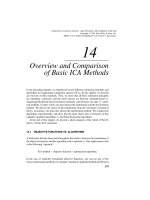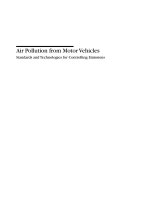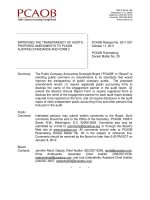Chapter 14: Standards and Regulations for Batteries and Battery Plants ppt
Bạn đang xem bản rút gọn của tài liệu. Xem và tải ngay bản đầy đủ của tài liệu tại đây (326.39 KB, 11 trang )
14
Standards and Regulations for
Batteries and Battery Plants
H. A. KIEHNE
14.1 SIGNIFICANCE OF STANDARDS
Standards are appointments and may become enforceable by jurisdictional law and
administrative regulations through signed contracts (for instance a sales contract)
and can be understood to be ‘‘approved technology rules’’.
The general features of standards are, in short:
. Standards are a service for technology.
. Standards are an economic and a technical form of cooperation (see also
DIN 820 Part 1).
. Standards are planned unifications of material and immaterial objects to
serve everybody.
. Standards may not lead to exceptional economic advantages for any party.
. Standards may not affect the progress of technology and innovations.
. Standards shall help to cut down trade barriers.
14.2 NATIONAL GERMAN STANDARDS AND REGULATIONS
The Deutsche Elektrotechnische Kommission (DKE) is in charge of designing
standards and regulations for the electrotechnical sector for Germany. The three
institutes for this job are the DIN (Deutsches Institut fu
¨
r Normung; German
Institute for Standardization), the DKE (Deutsche Kommission fu
¨
r Elektrotechnik;
German Electrotechnical Commission), and the VDE (Verein Deutscher Elektro-
Copyright © 2003 by Expert Verlag. All Rights Reserved.
techniker; German member of IEEE). Results of their work are the Deutsche
Normen, or German standards (DIN, DIN EN, and DIN IEC*), and the
Bestimmungen, or regulations (V DE and DIN).
Federal and state laws are superior to these standards. For example:
. Explosion regulations (Ex V).
. Regulations on working environments (Arb. Staett. V).
. Building regulations (Elt Bau V).
. Regulations for assembly halls (V Staett V).
. Regulations for office buildings (Gh V).
For the European Community the EU directives and regulations are of the same
importance and also gain law status through regulations.
Supporters and cosupporters of standards and regulations can also be
corporate bodies, e.g. producer unions, associations, and institutes.
National carriers are also existent, for instance in Russia and France. France
has a Ministry of Technology that issues these standards. In these countries
standards are so-to-speak laws.
The following committees are in charge of standardization of batteries, that is
secondary batteries (accumulators) and primary batteries (dry batteries) at the DKE:
K 371 Secondary rechargeable batteries (accumulators)
AK 371.0.2 Stationary lead accumulators
AK 371.0.3 Traction lead batteries
AK 371.0.4 Starter batteries
AK 371.0.5 Small valve-regulated lead-acid batte ries
UK 371.1 Secondary alkaline batteries
UK 371.2 Regulations
K 372 Galvanic primary elements and batteries
Above this, further standardization work is accomplished by the following
committees:
UK 351.4 Electric road vehicles
K 223 Emergency appliances and plants in buildings for public
assemblies, etc.
14.2.1 How Standards Come into Being
Producers, branch associations (e.g. German Battery Manufacturers Association,
member of ZVEI (Manufacturers Association of the Electronic and the Electro-
technical Industry)), and authorities can propose or request a standard at the DKE.
In case the committee in charge accepts the proposal, a team is put in charge of
forming the standards’ layout (draft), which in turn must pass the committee. Then
this layout is made public allowing for public opinion within a period of 4 months.
Any national drafted standard is automatically transformed to a European
draft under the responsibility of Comite
´
Europe
´
en de Normalisation Electrotechni-
que (CENELEC). The CENELEC members are asked to decide whether they want
to create based upon the national proposal a European standard or let it pass as a
national standard only in the country which made the proposal.
Copyright © 2003 by Expert Verlag. All Rights Reserved.
After reconciliation of the objections by the CENELEC committees and
possible changes, the final vote and passing by the national committees follows. In
case of approval all member states of the European Union have to take the layout of
the final version to edit it as an EN Standard. In the case only a national standard
has to be published the procedure is shown in Figure 14.1. Here only national
objections have to be regarded by the German National Committee; after
reconciliation of the objections and possible changes the final vote follows and the
layout is then printed as German National Standard (DIN).
Other general rules that have to be considered due to the cooperation between
CENELEC and IEC are not treated here, but can be referred to in special
publications on the subject.
14.3 INTERNATIONAL STANDARDS
14.3.1 International Electrotechnical Commission
The IEC (International Electrotechnical Commission) features the following
commissions in charge of standardization of batteries:
Figure 14.1 Schematic of the standardization process from the standard’s request to the
final standard. (From DIN 820.)
Copyright © 2003 by Expert Verlag. All Rights Reserved.
TC 21 Secondary rechargeable batteries (accumulators)
SC 21 A Secondary rechargeable alkaline batteries
TC 35 Dry batteries
Germany is a member of the IEC; the ‘‘reflecting committees’’ send their delegates to
the IEC committees as German delegations represented by a speaker; this is usually
the chairman of the corresponding German committee (called also ‘‘mirror-
committee’’).
Consultations on standards’ submissions are also made by working groups
resulting in IEC standards. The first step toward a new standard is the distribution of
draft documents to all member countries by the IEC’s Central Office (CO) in
Geneva.
The Central Office documents are subjected to a 2- or 6-month period of tim e
for the members (national committees) to vote on. In case of a sufficient majority of
votes, the CO document becomes an IEC standard, e.g. IEC Standard 60 254-1,
Lead-Acid Traction Batteries (3). Sometimes the margins between the IEC and the
ISO (International Standards Organization) are not clearly perceivable and may
pose problems. All drafts of IEC standards run in parallel as CENELEC drafts
under vote with aim to take over the IEC standard as EN Standard.
14.3.2 En Standards (CENELEC)
The CENELEC features ‘‘reflective committees’’ similar to the IEC, but these are
activated only to a small extent to prevent work to be done twice, so there are only
very few committees and working groups established.
Every IEC document (CO) or standard is followed by a questionnaire in
CENELEC countries whether or not to start a standardization process on the same
subject resulting in an EN standard. Depending on the result of the inquiry a halt of
all national standardization activities follows in order to attain accordance with the
international standards. The simplest way to do this is to make the IEC standard a
national standard, partially or as a whole with the same significance. Details on the
subject are referred to by special publications.
Obstacles for a fast integration into national standards are, for example:
. Established dimensions.
. Established safety-standards (Ex-directives VDE 0165, 0170, 0171).
. Different levels of technology.
Guideline for the work of all European National Standard Commit tees is to
Make proposals for international standards, not national standards and transfer
international standards to national standards.
Figure 14.2 shows in a very rough manner the way to a standard, worldwide,
on the European level, and on the national level. Cooperating partners of the
standardization organizations are associations such as worldwide-operating BCI
(Battery Council International, International Association of Battery Manufac-
turers). In Europe this function has EUROBAT (Federation of European
Manufacturers of Batteries). A treaty allowing EUROBAT to propose directly to
CENELEC standardization work links European battery manufacturers and
CENELEC, avoiding the way via the national committees. In Germany the German
Copyright © 2003 by Expert Verlag. All Rights Reserved.
Federation of Battery Manufacturers (member of ZVEI) cooperates with the DIN
organization.
14.4 PRODUCT STANDARDS, TESTING STANDARDS, AND
SAFETY STANDARDS
Standards can mainly be divided into these three main groups (6).
Product stand ards comprise main overall dimensions, weights, and electric data
on production series or on single parts. Example: DIN 43 595, titled ‘‘Lead-acid
accumulators; tubular plate-type cells for water- and land-bound vehicles, low
maintenance type. Nominal capacities; main dimensions.’’
Testing standards include testing methods for type and acceptance tests.
Example: DIN 43539, part 3 titled ‘‘Lead-acid accumulators; test methods, traction
cells and batte ries.’’
Combinations of dimensional and testing standards are also common.
Safety standards (or directives) comprise basic rules for the application of a
product ranging from installation to employment. Example: DIN 57 510 (VDE
0510), titled ‘‘VDE Directives for Accumulators and Battery Plants.’’
14.5 STANDARDS FOR DRY BATT ERIES (SELECTION)
. DIN IEC 86-1, Primary batteries. Part 1: General.
. DIN IEC 86-2, Primary batteries. Part 2: Standard sheets.
Figure 14.2 The way to standards: worldwide, Europewide, and nationwide.
Copyright © 2003 by Expert Verlag. All Rights Reserved.
Dry batteries are employed in countless applications, for original equipment as well
as for replacement. They are manufactured all over the world, making the need for
standardization of dimensions, voltages, and connecting techniques understandable.
Who has not heard of the classic sizes MONO, BABY, MIGNON, LADY, or A,
AA, AAA, and AAAA? Figure 14.3 describes the most important standardized
cylindrical cells. Figure 14.4 shows a survey on the most impor tant standardized
button-type cells.
14.6 STANDARDS FOR STARTER BATTERIES (SELECTION)
14.6.1 Existing German National Standards (Selection)
. DIN 72 310, Parts 1 and 2: Lead-acid accumulators; starter batteries. Series
numbers, construction.
. DIN 72 311: Lead-acid accumulators; starter batteries (several parts).
. DIN 72 311, Part 1: Lead-acid accumulators; starter batteries for cranking
lighting and ignition purposes, test methods.
. DIN 72 331, Parts 1 and 2: Lead-acid accumulators; starter batteries,
battery poles for starter batteries.
Figure 14.3 Survey on the most important standardized cylindrical (round) cells.
Copyright © 2003 by Expert Verlag. All Rights Reserved.
. DIN 72 332, Part 1: Lead-acid accumulators; starter batteries, battery
terminals for starter batteries.
. DIN 72 333, Parts 1–4: Lead-acid accumulators; starter batteries, battery
terminals for starter batteries, clamp fittings, terminal fittings with ground
straps, ground connectors, light clam p fittings.
. DIN 43 539, Part 2: Lead-acid accumulators; test methods, starter batteries
12 V. Harmonized (see EN 60 095-1).
14.6.2 IEC and EN Standards (Selection)
. IEC 60 095-1, EN 60 095-1: Lead-acid starter batteries; general require-
ments and test methods.
. IEC 60 095-2, EN 60 095-2: Lead-acid starter batteries: Dimensions of
batteries.
. IEC 60 095-3, EN 60 095-3: Lead-acid starter batteries: Dimensions and
markings of terminals.
14.7 STANDARDS FOR TRACTION BATTERIES (SELECTION)
14.7.1 Existing German National Standards (Selection)
. DIN 43 531: Lead-acid accumulators; traction batteries, 48 V for industrial
trucks: Dimensions, weights, electrical data.
. DIN 43 535: Lead-acid accumulators; traction batteries, 24 V for industrial
trucks: Dimensions, weights, electrical data.
Figure 14.4 Survey on the most important standardized button-type cells.
Copyright © 2003 by Expert Verlag. All Rights Reserved.
. DIN 43 536: Lead-acid accumulators; traction batteries, 80 V for industrial
trucks: Dimensions, weights, electrical data.
. DIN 43 537: Lead-acid accumulators; traction batteries for road-bound
electric vehicles, cells of low maintenance type: Nominal capacities, main
dimensions.
. DIN 43 538: Lead-acid accumulators; traction batteries for road-bound
electric vehicles; monobloc batteries of low maintenance type: Nomi nal
capacities, main dimensions.
. DIN 43 539, Part 3: Lead-acid accumulators: Test methods, traction cells
and batteries. Harmonized (see EN 60 254-1).
. DIN 43 595: Lead-acid accumulators ; tubular-plate type cells for land- and
water-bound vehicles, low maintenance type: Nominal capacities, main
dimensions. Harmonized (see EN 60 254-2).
14.7.2 IEC and EN Standards (Selection)
. IEC 60 254-1, EN 60 254-1, Part 1: Lead-acid traction batteries: General
requirements and methods of test.
. IEC 60 254-2, EN 60 254-2, Part 2: Lead-acid traction batteries:
Dimensions of traction battery cells.
14.8 STANDARDS FOR STATIONARY LEAD-ACID BATTERIES
(SELECTION)
14.8.1 Existing German National Standards (Selection)
. DIN 40 734: Lead-acid accumulators; stationary battery cells with positive
grid-type plates: Capacities, main dimensions
. DIN 40 736, Parts 1 and 2: Lead-acid accumulators; stationary battery cells
with positive tubular plates: Capacities, main dimensions, weights.
. DIN 40738: Lead-acid accumulators; stationary battery cells with Plante
´
plates, high-performance construction: Capacities, main dimensions,
weights.
. DIN 43 539, Part 4: Lead-acid accumulators; test methods, stationary
battery cells and batteries. Harmo nized (see EN 60 8961 and EN 60 896-2).
14.8.2 IEC and EN Standards (Selection)
. IEC 60 896-1, EN 60 896-1, Part 1: Stationary lead-acid batteries; vented
types: General requirements and methods of test.
. IEC 60 896-2, EN 60 896-2, Part 2: Stationary lead-acid batteries, valve-
regulated types (VRLA): General requirements and methods of test.
Copyright © 2003 by Expert Verlag. All Rights Reserved.
14.9 STANDARDS FOR PORTABLE MAINTENANCE-FREE, VALVE-
REGULATED LEAD-ACID (VRLA) CELLS
14.9.1 Existing German National Standards (Selection)
All are harmonized.
14.9.2 IEC and EN Standards (Selection)
. IEC 60 056-1, EN 60 056-1, Part 1: Portable lead-acid cells and batteries:
General requirements, functional characteristics, methods of test.
. IEC 60 056-2, EN 60 056-2, Part 2: Portable lead-acid cells and batteries:
Dimensions, terminals, marking.
. IEC 60 056-3, EN 60 056-3, Part 3: Portable lead-acid cells and batteries:
Safety recommendations for use in electric appliances.
14.10 STANDARDS FOR ALKALINE ACCUMULATORS
(SELECTION)
14.10.1 Existing German National Standards (Selection)
All are harmonized.
14.10.2 IEC and EN Standards (Selection)
. IEC 60 285, EN 60 285: Alkaline secondary cells and batteries; sealed
nickel/cadmium cylindrical rechargeable single cells.
. IEC 60 509, EN 60 609: Alkaline secondary cells and batteries; sealed
nickel/cadmium button rechargeable single cells.
. IEC 60 622, EN 60 622: Alkaline secondary cells and batteries; Sealed
nickel/cadmium prismatic rechargeable single cells.
. IEC 60 623, EN 60 623: Alkaline secondary cells and batteries; vented
nickel/cadmium prismatic rechargeable cells.
. IEC 61 150, EN 61 150: Alkaline secondary cells and batteries; sealed
nickel/cadmium rechargeable monobloc batteries in button cell design.
. IEC 61 438, EN 61 438: Possible safety and health hazards in the use of
alkaline secondary cells and batteries: Guide to equipment manufacturers
and users.
14.11 VDE REGULATIONS (SELECTION)
. VDE 0510: Regulation for accumulators and battery plants.
. VDE 0170: Regulation for mounting electric devices in medical facilities.
. VDE 0108: Regulation for mounting and operating emergency electric
equipment in public assembly buildings.
. VDE 0122: Regulation for electric equipment of road-bound electric
vehicles.
Copyright © 2003 by Expert Verlag. All Rights Reserved.
The German National Committee has proposed to transfer the revision of VDE 0510
in all parts into EN and IEC standards. This work is in pro gress with the relevant
CENELEC working groups.
14.12 OTHER GERMAN STANDARDS AND GUIDELINES
. VG (military defense equipment).
. LN (aeronautical standards).
. BN (railway standards).
. VDI Guidelines
14.13 OTHER INTERNATIONAL STANDARDS AND COMMITTEES
. ANSI American National Standards Institute (formerly AESC, ASA,
USASI)
. AQAP Allied Quality Assurance Publication (NATO demands and
standards)
. ASTM American Society for Testin g and Materials
. MIL Military Standards and Specifications
. MS Military Stand ards
. NEMA National Electric Manufacturers Association (United States)
. SAE Society of Automotive Engineers (United States)
14.14 SIGNIFICANCE OF STANDARDS AND REGULATIONS
REGARDING MANUFACTURER LIABILITY
Manufacturer and product liability, both concerning the same issue, is not a new
concept. The BG B (federal German law book) has commented the sub ject since
1915. Protection of the consumer has, similar to environmental protection, recently
been more publicly discussed. The regulating law in this regard in Germany is
paragraph 823 of the BGB, with a principle of indebtedness independent of liabili ty
(delict liability). According to this the fact that production techniques are state of the
art is not sufficient. Observation of the DIN standards is not an excuse for the
manufacturers, but is a first step tow ard lowering risks, as DIN standards have been
included in many decrees.
The manufacturer is liable for:
. Development errors.
. Construction deficiencies.
. Manufacturing faults.
This implies the necessity for the manufacturer to survey the quality of its products
and to check for compatibility of its product with other products.
Laws on the subject are not internationally uniform. In Germany manufactur-
ing deficiencies are not generally followed by the manufacturer’s liability, if the
manufacturing company, apart from the faulty product, turns out products that
correspond with standards and directions and the company disposes of a quality
Copyright © 2003 by Expert Verlag. All Rights Reserved.
supervision system that operates flawlessly, so these manufacturing faults are taken
as ‘‘uncontrollable drop-outs’’.
(See EU Directive titled ‘‘Assimilation of the laws and directives of the
member-states of the European Community on liability for faulty products’’.)
REFERENCES
1. IEC Directory.
2. IEC Yearbook, 2001.
3. IEC Catalogue of IEC publications, 2001.
4. ISO/IEC Directives Part 1, 1995.
5. IEC General Notes, 1995.
6. Agreement between the European Committee for Electrotechnical Standardization
(CENELEC) and the Federation of European Manufacturers of Batteries (EUROBAT)
on cooperation in the field of Electrotechnical Standardization covered by the scope of
CENELEC.
7. CENELEC International Regulations, Parts 1–4.
8. CENELEC Annual Report, 2001.
9. DIN-Mitteilungen.
10. DIN Katalog und Erga
¨
nzungen, 2001.
11. HA Kiehne. Electrochemical Storage Systems: International and National Standards.
EUREL Conference Proceedings, 1995, pp. 49–58.
12. IEC 50, Chapter 481. International Electrotechnical Vocabulary - Primary Cells and
Batteries.
13. IEC 50, Chapter 486. International Electrotechnical Vocabulary - Secondary Cells and
Batteries.
Copyright © 2003 by Expert Verlag. All Rights Reserved.









